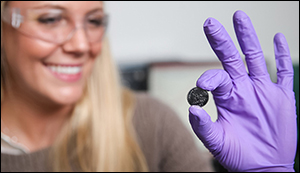Quantum dots made from fool’s gold boost battery performance
12. 11. 2015 | Vanderbilt University | news.vanderbilt.edu
If you add quantum dots – nanocrystals 10,000 times smaller than the width of a human hair – to a smartphone battery it will charge in 30 seconds, but the effect only lasts for a few recharge cycles.
However, a group of researchers at Vanderbilt University report in the November issue of the journal ACS Nano that they have found a way to overcome this problem: Making the quantum dots out of iron pyrite, commonly known as fool’s gold, can produce batteries that charge quickly and work for dozens of cycles.

The research team headed by Assistant Professor of Mechanical Engineering Cary Pint and led by graduate student Anna Douglas became interested in iron pyrite because it is one of the most abundant materials in the earth’s surface. It is produced in raw form as a byproduct of coal production and is so cheap that it is used in lithium batteries that are bought in the store and thrown away after a single use.
When the particles get very small, generally meaning below 10 nanometers (40 to 50 atoms wide), the nanoparticles begin to chemically react with the electrolytes and so can only charge and discharge a few times. So this size regime is forbidden In commercial lithium-ion batteries.
Aided by Douglas’ expertise in synthesizing nanoparticles, the team set out to explore this “ultrasmall” regime. They did so by adding millions of iron pyrite quantum dots of different sizes to standard lithium button batteries like those that are used to power watches, automobile key remotes and LED flashlights. They got the most bang for their buck when they added ultrasmall nanocrystals that were about 4.5 nanometers in size. These substantially improved both the batteries’ cycling and rate capabilities.
Read more at Vanderbilt University
Image Credit: Vanderbilt University
-jk-




